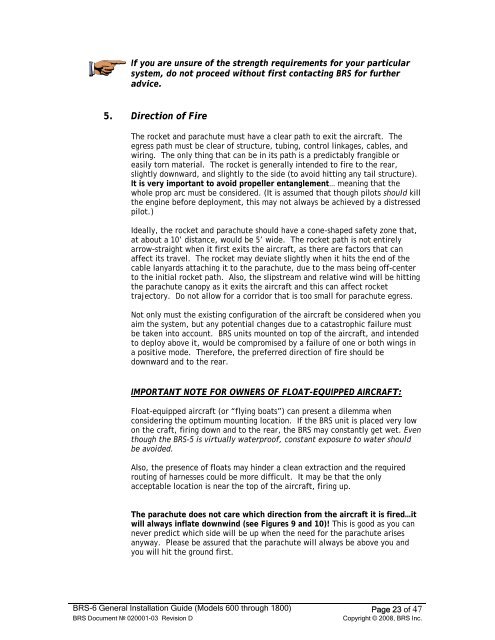BRS-6 General Installation Guide - CAFE Foundation
BRS-6 General Installation Guide - CAFE Foundation
BRS-6 General Installation Guide - CAFE Foundation
Create successful ePaper yourself
Turn your PDF publications into a flip-book with our unique Google optimized e-Paper software.
If you are unsure of the strength requirements for your particular<br />
system, do not proceed without first contacting <strong>BRS</strong> for further<br />
advice.<br />
5. Direction of Fire<br />
The rocket and parachute must have a clear path to exit the aircraft. The<br />
egress path must be clear of structure, tubing, control linkages, cables, and<br />
wiring. The only thing that can be in its path is a predictably frangible or<br />
easily torn material. The rocket is generally intended to fire to the rear,<br />
slightly downward, and slightly to the side (to avoid hitting any tail structure).<br />
It is very important to avoid propeller entanglement… meaning that the<br />
whole prop arc must be considered. (It is assumed that though pilots should kill<br />
the engine before deployment, this may not always be achieved by a distressed<br />
pilot.)<br />
Ideally, the rocket and parachute should have a cone-shaped safety zone that,<br />
at about a 10’ distance, would be 5’ wide. The rocket path is not entirely<br />
arrow-straight when it first exits the aircraft, as there are factors that can<br />
affect its travel. The rocket may deviate slightly when it hits the end of the<br />
cable lanyards attaching it to the parachute, due to the mass being off-center<br />
to the initial rocket path. Also, the slipstream and relative wind will be hitting<br />
the parachute canopy as it exits the aircraft and this can affect rocket<br />
trajectory. Do not allow for a corridor that is too small for parachute egress.<br />
Not only must the existing configuration of the aircraft be considered when you<br />
aim the system, but any potential changes due to a catastrophic failure must<br />
be taken into account. <strong>BRS</strong> units mounted on top of the aircraft, and intended<br />
to deploy above it, would be compromised by a failure of one or both wings in<br />
a positive mode. Therefore, the preferred direction of fire should be<br />
downward and to the rear.<br />
IMPORTANT NOTE FOR OWNERS OF FLOAT-EQUIPPED AIRCRAFT:<br />
Float-equipped aircraft (or “flying boats”) can present a dilemma when<br />
considering the optimum mounting location. If the <strong>BRS</strong> unit is placed very low<br />
on the craft, firing down and to the rear, the <strong>BRS</strong> may constantly get wet. Even<br />
though the <strong>BRS</strong>-5 is virtually waterproof, constant exposure to water should<br />
be avoided.<br />
Also, the presence of floats may hinder a clean extraction and the required<br />
routing of harnesses could be more difficult. It may be that the only<br />
acceptable location is near the top of the aircraft, firing up.<br />
The parachute does not care which direction from the aircraft it is fired…it<br />
will always inflate downwind (see Figures 9 and 10)! This is good as you can<br />
never predict which side will be up when the need for the parachute arises<br />
anyway. Please be assured that the parachute will always be above you and<br />
you will hit the ground first.<br />
<strong>BRS</strong>-6 <strong>General</strong> <strong>Installation</strong> <strong>Guide</strong> (Models 600 through 1800) Page 23 of 47<br />
<strong>BRS</strong> Document № 020001-03 Revision D Copyright © 2008, <strong>BRS</strong> Inc.

















